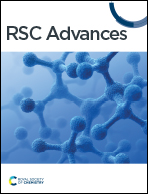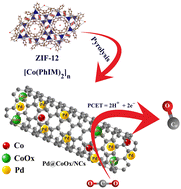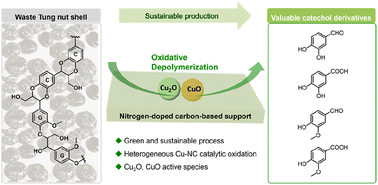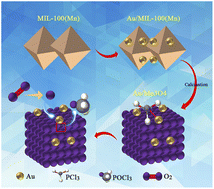
RSC Advances
Subject area
Redox articles published in the last
6 months

Ag/AgBr-oxygen enriched g-C3N4 for efficient photocatalytic degradation of trimethylamine
In this study, Ag/AgBr–O-gCN samples with ternary Z-type heterojunctions were prepared by in situ photoreduction using water as the reducing agent for generating Ag/AgBr active species and oxygen doping.

RSC Adv., 2024,14, 14068-14079
https://doi.org/10.1039/D4RA02395A
High performance electrochemical CO2 reduction over Pd decorated cobalt containing nitrogen doped carbon
Efficient electrocatalytic CO2 reduction reaction (eCO2RR) to various products, such as carbon monoxide (CO), is crucial for mitigating greenhouse gas emissions and enabling renewable energy storage.

RSC Adv., 2024,14, 13017-13026
https://doi.org/10.1039/D4RA01641F
Investigation into the impact of CeO2 morphology regulation on the oxidation process of dichloromethane
Four distinct CeO2 catalysts featuring varied morphologies (nanorods, nanocubes, nanoparticles, and nano spindle-shaped) were synthesized through a hydrothermal process and subsequently employed in the oxidation of dichloromethane (DCM).

RSC Adv., 2024,14, 12265-12277
https://doi.org/10.1039/D4RA01326C
Boosting oxygen evolution reaction rates with mesoporous Fe-doped MoCo-phosphide nanosheets
In this study, we explord the catalytic activity of MoCoFephosphide nanosheets as highly active and stable catalysts for OER. Electrochemical analysis exhibits a low overpotential of 250 mV in (1 M KOH), achieving a current density of 10 mA cm−2 with a low Tafel slope of 43.38 mV dec−2.

RSC Adv., 2024,14, 10182-10190
https://doi.org/10.1039/D4RA00146J
Selective electrooxidation of 5-hydroxymethylfurfural at low working potentials promoted by 3D hierarchical Cu(OH)2@Ni3Co1-layered double hydroxide architecture with oxygen vacancies
An effective and stable catalyst with 3D hierarchical architecture was synthesized by electrodepositing Ni3Co1-LDH nanosheets on copper foam-supported Cu(OH)2 nanorods. The catalyst can be used to prepare FDCA continuously, showing great potential in the electrochemical conversion of biomass.

RSC Adv., 2024,14, 10104-10112
https://doi.org/10.1039/D4RA00769G
Expression of concern: Highly porous copper-supported magnetic nanocatalysts: made of volcanic pumice textured by cellulose and applied for the reduction of nitrobenzene derivatives
RSC Adv., 2024,14, 9798-9798
https://doi.org/10.1039/D4RA90026J
Modified photoanode by in situ growth of covalent organic frameworks on BiVO4 for oxygen evolution reaction
COF-Azo and COF-Ben are grown in situ on a modified BiVO4 photoanode, which exhibit better catalytic performance in OER.

RSC Adv., 2024,14, 9609-9618
https://doi.org/10.1039/D4RA00899E
Functionalisation of alkali-resistant nanoporous glass via Au nanoparticle decoration using alkaline impregnation: catalytic activity for CO removal
This study demonstrates that a nanoporous glass can be decorated with Au nanoparticles using an alkali impregnation method. The resulting composite exhibits high catalytic activity in CO oxidation.

RSC Adv., 2024,14, 8214-8221
https://doi.org/10.1039/D3RA07333E
The discrepancy of NH3 oxidation mechanism between SAPO-34 and Cu/SAPO-34
The difference of NH3 oxidation mechanism over SAPO-34 and Cu–SAPO-34 was studied.

RSC Adv., 2024,14, 7499-7506
https://doi.org/10.1039/D4RA00248B
Magnetic MnFe2O4/ZIF-67 nanocomposites with high activation of peroxymonosulfate for the degradation of tetracycline hydrochloride in wastewater
Schematic illustration of the reaction mechanisms in the MnFe2O4/ZIF-67/PMS system.

RSC Adv., 2024,14, 7528-7539
https://doi.org/10.1039/D3RA08511B
A comparative study of α-Ni(OH)2 and Ni nanoparticle supported ZIF-8@reduced graphene oxide-derived nitrogen doped carbon for electrocatalytic ethanol oxidation
Ethanol electrooxidation is an important reaction for fuel cells, however, the major obstacle to ethanol electrocatalysis is the splitting of the carbon–carbon bond to CO2 at lower overpotentials.

RSC Adv., 2024,14, 5524-5541
https://doi.org/10.1039/D3RA08208C
Sustainable production of catechol derivatives from waste tung nutshell C/G-type lignin via heterogeneous Cu–NC catalytic oxidation
A heterogeneous oxidative process is reported towards sustainable production of valuable catechol derivatives from the depolymerization of Tung nutshell C/G lignin by Cu–NC catalytic process. The CuO and Cu2O might be active species for oxidation.

RSC Adv., 2024,14, 5069-5076
https://doi.org/10.1039/D3RA08052H
Microalgae-derived Co3O4 nanomaterials for catalytic CO oxidation
Sustainable nanosized Co3O4 catalysts, derived from microalgae extracts and post-synthesis treatments, were employed for oxidative CO removal.

RSC Adv., 2024,14, 4575-4586
https://doi.org/10.1039/D4RA00343H
Manganese-oxide-supported gold catalyst derived from metal–organic frameworks for trace PCl3 oxidation in an organic system
An Au/Mn3O4 catalyst derived from Mn-MIL-100 exhibits a high catalytic performance for trace PCl3 oxidation with oxygen in an organic system through an MvK-style supply of oxygen.

RSC Adv., 2024,14, 4230-4243
https://doi.org/10.1039/D3RA08566J
Recent advances in single-atom alloys: preparation methods and applications in heterogeneous catalysis
Single-atom alloys (SAAs) are a different type of alloy where a guest metal, usually a noble metal (e.g., Pt, Pd, and Ru), is atomically dispersed on a relatively more inert (e.g., Ag and Cu) host metal.

RSC Adv., 2024,14, 3936-3951
https://doi.org/10.1039/D3RA07029H
Efficient catalytic activity of NiO and CeO2 films in benzoic acid removal using ozone
(1) CeO2 films increases TOC removal in comparison with NiO films in benzoic acid elimination. (2) Both CeO2 and NiO films can be easily recovered from the ozonation system.

RSC Adv., 2024,14, 3923-3935
https://doi.org/10.1039/D3RA07316E
Self-assembled copper nanoclusters used to mimic peroxidase for glucose detection
A sensing system for glucose derived from a self-assembled copper nanoclusters-based nano-enzyme and glucose oxidase.

RSC Adv., 2024,14, 3261-3266
https://doi.org/10.1039/D3RA07598B
Catalytic hydrolysis of carbonyl sulfide in blast furnace gas over Sm-Ce-Ox@ZrO2 catalyst
Carbonyl sulfur (COS) is a prominent organic sulfur pollutant commonly found in the by-product gas generated by the steel industry.

RSC Adv., 2024,14, 3135-3145
https://doi.org/10.1039/D3RA06833A
Ni–Fe bimetallic catalysts with high dispersion supported by SBA-15 evaluated for the selective oxidation of benzyl alcohol to benzaldehyde
A wetness impregnation method was used to impregnate the substrate with a substantial quantity of oleic acid together with a metal precursor, leading to significantly dispersed Ni–Fe bimetallic catalysts based on mesoporous SBA-15.

RSC Adv., 2024,14, 2300-2310
https://doi.org/10.1039/D3RA07086G
Retraction: Robust, highly active, and stable supported Co(II) nanoparticles on magnetic cellulose nanofiber-functionalized for the multi-component reactions of piperidines and alcohol oxidation
RSC Adv., 2024,14, 1675-1675
https://doi.org/10.1039/D3RA90129G
A novel concept and design for highly efficient photoelectrocatalytic materials with high performance, stability, and charge transport properties: development of an innovative next-generation green technology
In semiconductors, generating charges via catalysis is a highly challenging task and characteristic of heterojunction photoanodes.

RSC Adv., 2024,14, 1581-1592
https://doi.org/10.1039/D3RA05126A
Component-controlled synthesis of PdxSny nanocrystals on carbon nanotubes as advanced electrocatalysts for oxygen reduction reaction
A series of PdxSny nanocrystals loaded on carbon nanotubes (CNTs) nanohybrids have been synthesized. Due to the proper alloy constituent and the strong interplay between the two components, the resultant Pd3Sn/CNTs exhibit excellent ORR activity.

RSC Adv., 2024,14, 771-778
https://doi.org/10.1039/D3RA07657A
Anderson-type polyoxometalate-based metal–organic framework as an efficient heterogeneous catalyst for selective oxidation of benzylic C–H bonds
Self-assembly of Anderson-type polyoxometalate {CrMo6} with Cu2+ and bistriazole L affords POMOF-1 that works cooperatively with NPHI for oxidative transformation of benzylic C–H bonds into carbonyl compounds.

RSC Adv., 2024,14, 364-372
https://doi.org/10.1039/D3RA07120K
Advancing nitrate reduction to ammonia: insights into mechanism, activity control, and catalyst design over Pt nanoparticle-based ZrO2
Tailoring nitrate reduction: unraveling mechanisms, modulating activity, and designing Pt nanoparticle-based ZrO2 catalysts for enhanced ammonia production.

RSC Adv., 2023,13, 34497-34509
https://doi.org/10.1039/D3RA06449B
Exploring the source of ammonia generation in electrochemical nitrogen reduction using niobium nitride
A NbN catalyst is prepared by the urea-glass route for NRR, with the produced NH3 originating from the leaching of NbN, rather than from an electrochemical reaction.

RSC Adv., 2023,13, 34410-34415
https://doi.org/10.1039/D3RA06475A
Browse by Subject
- All (336 articles)
- Atomic/elemental (14 articles)
- Bioanalytical (65 articles)
- Chemometrics (30 articles)
- Crystallography (164 articles)
- Electroanalytical (57 articles)
- Imaging/microscopy (32 articles)
- Mass spectrometry (22 articles)
- Medical diagnostics (77 articles)
- Microfluidics (17 articles)
- Nanoanalysis (20 articles)
- Separation science (27 articles)
- Spectroscopy (95 articles)
- All (272 articles)
- Bioinorganic chemistry (49 articles)
- Bioorganic chemistry (27 articles)
- Biotechnology (51 articles)
- Cellular chemistry (56 articles)
- Computational (84 articles)
- Drug delivery (78 articles)
- Drug discovery (181 articles)
- Imaging/diagnostics (15 articles)
- Molecular biology (6 articles)
- Nanotechnology (44 articles)
- Natural products (30 articles)
- Pharmacology (85 articles)
- Photobiology (15 articles)
- Polymorphism (pharma) (1 article)
- Structural biology (12 articles)
- Toxicology (3 articles)
- All (555 articles)
- Biomaterials (101 articles)
- Biopolymers (99 articles)
- Carbon materials (100 articles)
- Composites (247 articles)
- Electronic materials (96 articles)
- Encapsulation (1 article)
- Energy applications (84 articles)
- Films/membranes (82 articles)
- Gels & soft matter (36 articles)
- Inorganic materials (48 articles)
- Medical materials (66 articles)
- Nanomaterials (125 articles)
- Optical materials (51 articles)
- Organic materials (55 articles)
- Polymers (133 articles)
- All (349 articles)
- Assembly (11 articles)
- Biotechnology (30 articles)
- Carbon nanomaterials (80 articles)
- Imaging/microscopy (17 articles)
- Nanoanalysis (42 articles)
- Nanocatalysis (31 articles)
- Nanomaterials (217 articles)
- Nanomedicine (43 articles)
- Nanotoxicology (55 articles)
- Optical nanomaterials (33 articles)
- Synthesis (12 articles)
- All (173 articles)
- Bioorganic (17 articles)
- Catalysis (46 articles)
- Fine chemicals (26 articles)
- Natural products (23 articles)
- Physical organic (8 articles)
- Stereochemistry (11 articles)
- Supramolecular (3 articles)
- Sustainable synthesis (35 articles)
- Synthetic methodology (100 articles)
- Total synthesis (13 articles)
- All (320 articles)
- Biophysics (2 articles)
- Charge transfer (28 articles)
- Electrochemistry (13 articles)
- Energy research (18 articles)
- Imaging/microscopy (5 articles)
- Kinetics & dynamics (40 articles)
- Materials (104 articles)
- Mechanics (34 articles)
- Nanoscience (69 articles)
- Photoscience (26 articles)
- Quantum & theoretical (90 articles)
- Simulations (23 articles)
- Single molecules (40 articles)
- Soft matter (5 articles)
- Spectroscopy (7 articles)
- Surfaces & interfaces (71 articles)